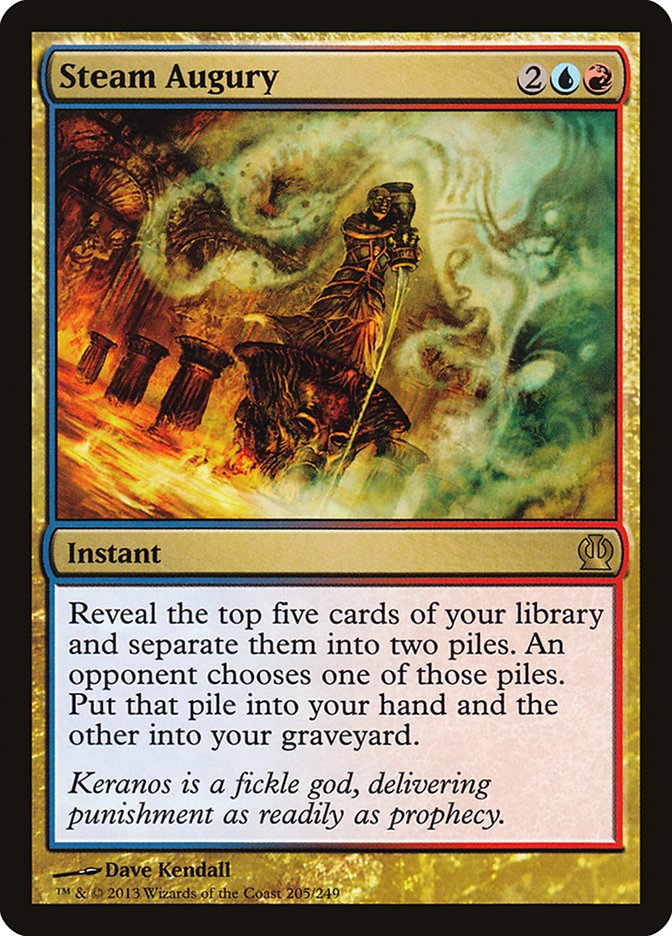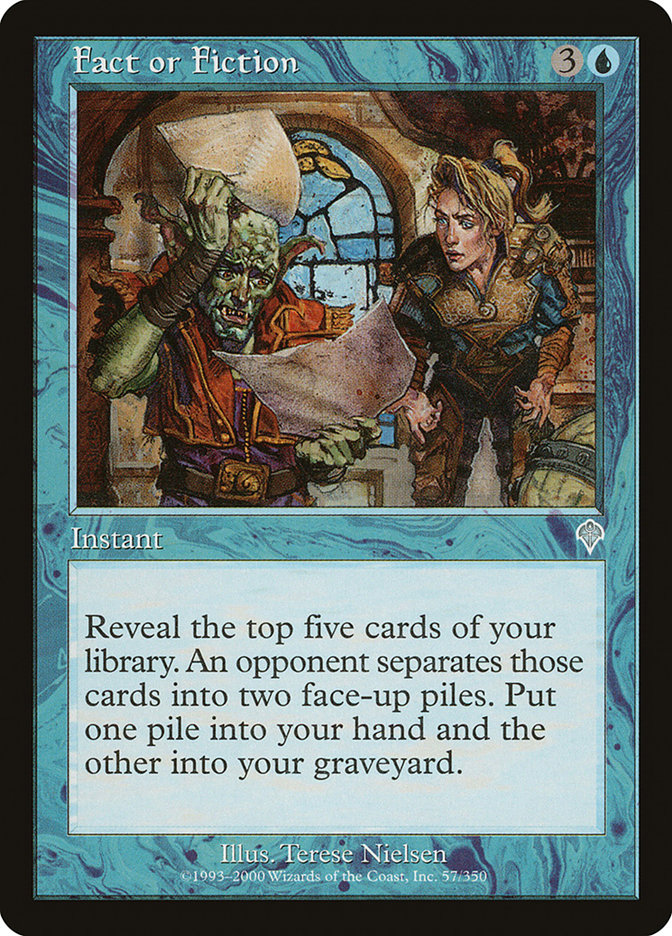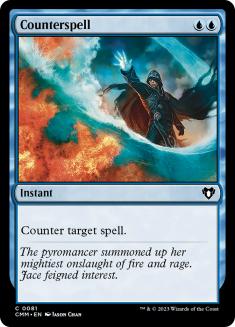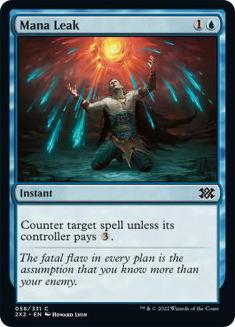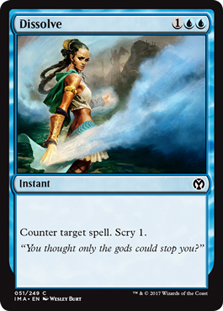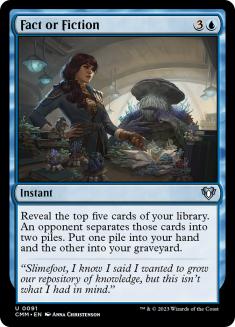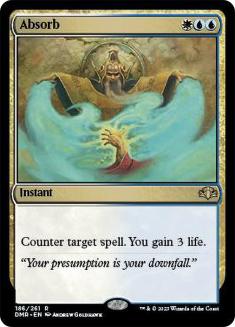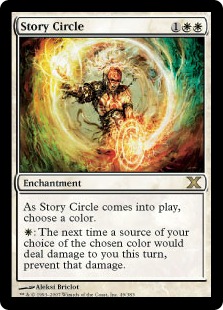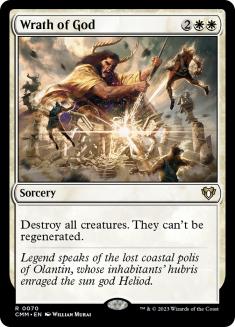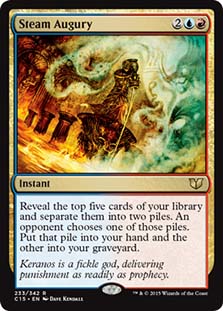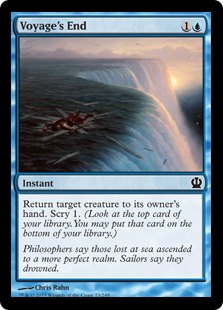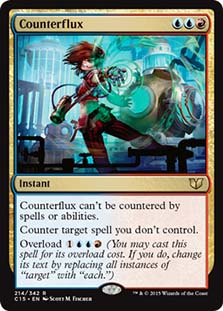This is new Theros card Steam Augury:
If you have been playing for a while, you might recognize Steam Augury as a reimagining of a popular spell from Invasion called Fact or Fiction:
In its day, Fact or Fiction was one of the most highly regarded and skill-testing spells to play and play against across every relevant format (up to and including Vintage!)
Fact or Fiction was what you might call "unambiguously powerful." It was a guaranteed three-for-one (if what you actually wanted was three cards), could serve as a more powerful Impulse, and forced your opponent to make decisions (many of which would be value leaking)—all at instant speed. WotC R&D has been hesitant to print card advantage at instant speed since anything thicker than an Inspiration ends up being a Gifts Ungiven or a Sphinx’s Revelation. And Fact or Fiction was one of the greats.
But our focus today is not just Fact or Fiction but its thematic heir, Steam Augury.
Three-For-One
In the past you could always—every single time—get a three-for-one (or better) if you wanted one off of a Fact or Fiction, and there were and are cards (Mageta the Lion, maybe Prognostic Sphinx today) that reward players just for increasing the tonnage of cardboard in their hands. Imagine for a moment—all other things held equal—you don’t (and won’t) kill your opponent or anything, and he taps for a Fact or Fiction, revealing:
How might you split that?
All other things held equal, most amateur players (especially early on) would split:
Counterspell + Island v. Mana Leak + Island + Island
The theory here is that the piles are as close to equal in strength as the five cards can give you.
"Fair" piling rarely produced the optimal splits because all other things held equal, the Fact or Fiction player could always take the slightly better "fair" pile, gaining subtle advantages over time in addition to pure cardboard advantage.
Given this example, in a long game most Fact or Fiction players would probably take the Counterspell pile (because Mana Leak might cease being a real card), but in a shorter game, a Mageta game, or a game where the opponent is tight on lands, the Mana Leak hand might be the stronger. But the important thing to note is that the Fact or Fiction player would always have the option to take the three-card pile; that certainty of a three-for-one (if you wanted it) was one of the hallmarks of the original.
Again, all other things held equal, many experienced pro players might split:
Counterspell + Mana Leak v. Island + Island + Island
Notice how the Fact or Fiction player now has to make the choice. All other things held equal, three cards are better than two cards. But in a long game especially, Counterspell is the best card in the set. They’d have to look at their hand and see if they had a land for next turn; if they did, they’d have to think about how much they would need to hit land drops two, three, or four turns down the line.
Ultimately, a ton of players would take the three-card/three-land pile, especially if they already had a Counterspell. And that decision might end up costing them the game . . . or winning it. If that Fact or Fiction fired on turn 4 and its caster had no lands? They’d snap the three and probably be right. See how much better the permission against piling is than the fair piling? Wouldn’t you rather your opponent’s three-for-one was Island + Island + Island rather than Mana Leak + Island + Island relatively early?
Why did we start on this model?
Because the first, most basic tenet of Fact or Fiction—that you can always get three cards if you want them—is no longer absolutely true with Steam Augury.
Imagine it’s 2013 and we have a similar "all other things held equal" spot where you attack, you don’t kill your opponent (and have no immediate way of killing your opponent), and they run the end-of-turn Steam Augury, flipping over:
Because of the redundancy of this imaginary five pile, I am going to just throw out 1-4/4-1 piles for now. If you want a Dissolve, you can get one with "Dissolve + Island v. Dissolve + Island + Island" split while guaranteeing yourself a second card; the same is true for if you really, really want an Island.
Ergo for this one we are only going to discuss two-three/three-two piles. The possibilities are:
Dissolve + Island v. Dissolve + Island + Island
Dissolve + Dissolve + Island v. Island + Island
Dissolve + Dissolve v. Island + Island + Island
We characterized a land + Counterspell v. two-land + Counterspell split as typical of amateur (or at least less experienced) play with Fact or Fiction; I would tend to say that in most cases the basic strategy is the "right" split for the Steam Augury player.
When the piles are:
Dissolve + Island v. Dissolve + Island + Island
Unless you have some incredibly good reason (and even a Storm Seeker ready to fire probably wouldn’t suffice), you are going to give them the two-card pile, right? Because hey, free Island?
I like this split because you are going to get a predictable outcome. If the piles are split on a paradigm of being relatively even, you are unlikely to get the bigger pile (the opposite of fair piling Fact or Fiction), but you are still getting a two-for-one, and here you’re ensuring your next land drop while giving yourself an awesome action card. While not the best possible outcome, Dissolve + Island is a good payoff for your four mana I think.
That said, even with three lands in the mix, I think it is hard to "force" a three-card pile. Much of the time, Steam Augury is going to be an Inspiration that cedes options to the graveyard and gives up information to the opposite side of the table.
Imagine the opponent attempts the lands-against-spells classic of:
Island + Island + Island v. Dissolve + Dissolve
When a Fact or Fiction player’s opponent makes a lands-against-spells split, they are forcing the actual Fact or Fiction caster to evaluate their hand and balance card advantage against planning.
But what about when a Steam Augury player makes a similar split and asks their opponent to choose for them?
Well, first of all, why would they ever make this split?
If you started out slow, look at your hand, and see exactly two threats that you will be able to cast over the next two turns, it is not particularly likely that you are going to give them that double Dissolve pile. You are going to push those three Islands at them, and that is going to be that. You will not look back. If you are playing a quick deck that can play two threats next turn and two threats, you might actually want to keep them off their lands (but have no fear of a pair of glorified Cancel).
What if you’re already winning pretty solidly? What if you have two or three good threats down, but you can smell a Planar Cleansing (implying they need to hit two drops whether they have lands in hand or not) and counterspells are irrelevant (because you don’t plan to cast anything until they tap for that Planar Cleansing they haven’t hit six for). What liability is there in giving them the Dissolve pile? Even if they have lands, you are going to beat (maybe beat again), they are going to tap for their big six, and you are going to resolve your next threat whether they have that pair of counterspells or not. Sure, if they have two more good answers and/or you draw (slash have) nothing, you might be in trouble. But then again, with a good plan and a decent clock, you might deal the most humiliating kind of loss to a blue player that there is: a loss with counters in hand.
What do all of these things have in common?
The Steam Augury player can’t actually control the ability to draw either three cards or guarantee a two-land hand, which is tough. Even if you are going to give them triple Islands most of the time with this example, the point is you have complete control and can tune the opponent’s pile based on your hand and your plan, which is almost the opposite of Fact or Fiction.
I think that:
Dissolve + Dissolve + Island v. Island + Island
Is the weirdest of these three possibilities.
When your opponent puts these piles in front of you, I wouldn’t be surprised if your bullspit detector started firing. What is this guy’s game? What pile does he even want?
If Steam Augury grows to anywhere near the popularity of Fact or Fiction, learning to play against it specifically will likely become an important skill for the next two years. If that is the case, I think that you should probably get used to asking yourself this question:
"What pile do they want and why?"
This pile is so obviously stronger than Island + Island that it should surprise no one for the opponent to want it. The question is can they realistically expect a competent opponent to ever give it to them? As you will only give it to them if there is some compelling reason they absolutely need to hit consecutive Islands, you have to determine if your likelihood of loss in that case is actually mitigated by a guaranteed next land drop paired by not only the possibility of drawing lands naturally but the impact of scry 1 coming from one or more Dissolves.
From both a tonnage and a card quality standpoint, the three-card pile is just a mile better than the two-card pile. At the point that your opponent is casting fours, there has to be something really off-label going on for them to price a single Island at double counterspell.
In order to make this split, you have to assume the opponent would be at least okay with getting stuck with this pile. In fact, I would personally assume less that this is the pile they want than they just want to hit two consecutive lands. It is just so unlikely you would give them the stacked three-pile, and they can live with this one because it will hit consecutive lands. Such a weird split (that someone will actually make at some point in the not too distant future).
Five-Spell Fact or Fictions
All the rules of pile splitting tend to go out the window with the dreaded five-spell Fact or Fiction. Your opponent can take the three-card pile, and the three-card pile is three spells. I have seen many a playtest game fold as soon as a five-spell Fact or Fiction hit . . . But it turns out that there is tremendous value that can be extracted by strong play even when the worst occurs.
On the way to making Top 8 at Fact or Fiction’s inaugural Pro Tour, Hall of Famer Zvi Mowshowitz was presented with a truly terrible Fact or Fiction dilemma. He had a Blastoderm and an opponent on five life when these five cards were revealed:
Zvi had two threats in hand, including a Jade Leech; remember, the opponent was on five.
How would you have split this one?
See why five-spell Fact or Fictions were so demoralizing?
Zvi made these piles:
Absorb + Counterspell + Story Circle v. Fact or Fiction + Wrath of God
Zvi played the man, not the cards on that one. In order to win, he had to not only gamble but bet that his opponent would err!
He correctly predicted that the opponent, giddy over new card Fact or Fiction, would be apt to take the Fact or Fiction pile, so he sweetened the pot with a direct answer to Blastoderm in Wrath of God.
But the most dangerous card in this pile is Story Circle!
Zvi might not have been able to beat just the Story Circle; given the way the game played out, I would guess he would have actually had a better chance of beating Fact or Fiction + Wrath of God + the two permission cards than just the Story Circle.
If the opponent had taken and then just played Story Circle, he could have neutralized Zvi’s Blastoderm, and eventually it would have faded away. Most of Zvi’s creatures were green, meaning he could save the permission cards for other threats and just bide his time. Given that, the Absorb pile is almost unbeatable unless Zvi draws a ton of red and artifact threats in short order while the opponent draws nothing.
But he made the permission cards seem irrelevant by putting them together; after all, he was already threatening lethal on the table. You can have these irrelevant permission cards if you want them was the message. You really have to kill this Blastoderm, don’t you? Moreover, Zvi gave the opponent a combination of a scratch to his itch and a way to solve his problem already on the battlefield; he bit.
Now, can you imagine playing against a player of that caliber and making the same split yourself with a Steam Augury?
You would get the Wrath of God pile and lose the same way Zvi’s opponent did. An Absorb? Fat chance of you getting that! He Wrathed the ‘Derm; Zvi played the Jade Leech. The opponent Fact or Fictioned again, didn’t hit what he needed, and died to the Jade Leech. With an unbeatable pile available to him.
Here’s the thing with five-spell Steam Augurys . . .
They aren’t completely demoralizing anymore; heck, the Steam Augury player can’t even auto-take the three-card pile! Five-spell Steam Augurys are going to give you some good meat (i.e., two spells more often than not), but they are not going to end playtest games immediately the same way their predecessors did.
Incidentally, what do you think the right Steam Augury split would have been on Zvi’s masterful anti Fact or Fiction? I am leaning toward:
Absorb + Story Circle v. Counterspell + Wrath of God + Fact or Fiction
And you expect to get the three-card pile (given that the opponent knows he can’t beat the two-pile) but can follow up immediately on the Jade Leech.
Super Impulse
One of the most famous ways to use a Fact or Fiction was as a big Impulse. That is, you flip over the next five cards and (in the one-four sets) get just one.
For example, your opponent plays a huge, must-counter sorcery (for sake of argument, a lethal Blaze).
You Fact or Fiction in response, revealing a counterspell and four other cards.
Your opponent puts the counterspell all by itself, and . . .
If you really didn’t have anything, you would take the counterspell and thank your lucky stars that Fact or Fiction was there to act as an Impulse.
But what often happened was that you already had a counterspell and the opponent would make the one-four split, resulting in a four-for-one! You would counterspell their face from your hand and come off their turn super fat with wins in grip.
Both sides are potentially great for you player here. If you get the counterspell (and need a counterspell), you simply don’t lose (which is great). If you didn’t need the counterspell, the one-four split results in a massive amount of card advantage, and the must-counter gets countered anyway.
Now let’s fast forward to 2013 . . .
Your opponent is on five.
You tap all the manas. Boom. Rakdos’s Return for five! If this card hits, the opponent is very likely to be dead, and even if he can weasel his life total up, he’s probably empty.
Predictable: Steam Augury in response, tapping four of eleven available lands, flipping:
The split goes Dissolve against. Which do you give him?
In this extreme example, there is probably little downside to giving the opponent four lands. It isn’t even much of a bluff in my opinion. If he needed the counterspell, he ain’t getting it. Whether the four Islands are going to put his hand big enough to withstand the Rakdos’s Return is kind of beside the point if he is going to be at zero life.
I would guess most of us concur on letting him have the four-for-one. But what about:
If he splits it Augury v. Islands, that might tell you something. The Islands are likely as irrelevant as they are in Dissolve v. Islands, whereas Augury can potentially keep him digging for an answer. In that case, I think we see again a straightforward decision.
But what about:
Steam Augury + Island v. Island + Island + Island
This would be a weird split for someone who is about to die, right?
It also makes you wonder about the person making the split. Three naked Islands are not scary. Four naked Islands were not particularly scary a minute ago. Perhaps adding an Island to the spell pile gives the impression that he doesn’t really need the Steam Augury; well good, because you really aren’t getting it.
In contrast. he absolutely can’t make this one:
Steam Augury + Island + Island v. Island + Island
You are going to give him Island + Island every time on that one.
Now, what about a more difficult split involving a lone counterspell?
Think for a moment as the Steam Augury player how you would want to split this pile if you wanted the Dissolve.
Dissolve against is a bold one-four split, with Steam Augury in the opposite pile doing work for your agenda. For one thing, you are going to have very different pile choices depending on who you are playing against in this situation.
I know that I have personally gone chasing rabbits at the thought of my opponent embarking on the unknown in the past (and I have pretty substantial experience), so there was a time at least that I would have for sure given my opponent Dissolve. If you want Dissolve, that is great for you.
Since we said the Steam Augury player has eleven lands, a Steam Augury pile keeps him alive even if he needed the Dissolve, at least long enough to cast another Steam Augury in the hopes of flipping a counterspell and four other cards juicy enough that he can get his hands on the counterspell.
I think the vast majority of experienced players in the Rakdos’s Return seat in 2013 are going to want to terminate the game here and are going to do everything in their power to cut off relevant answers, so that Steam Augury better find two Dissolves, a Dissolve and a Counterflux, or whatnot . . . or the game is going to end regardless of how many cards have been accumulated.
How can we influence the likelihood of obtaining the Dissolve? Does Dissolve + Island against do anything but make our Steam Augury pile smaller? We have said repeatedly that in a near-death situation, no one is frightened of Island! How about Dissolve + Voyage’s End? Voyage’s End is a good card—but only if the game keeps going. It certainly makes us seem less desperate, but my read is that it also just makes it less painful for the opponent to choose the already bigger Steam Augury pile.
Steam Augury keeps us going for a stack, but (again assuming there is no Dissolve/Counterflux /Swan Song hiding already) there has to be something great at the end of the second Steam Augury or we are just going to see the same decision set play out with fewer options.
Now imagine a less focused Steam Augury of two counterspells:
While there are a great number of ways to split a four-spell pile of five distinct cards, there are really only two models worth talking about:
Dissolve + Counterflux v. Voyage’s End + Steam Augury + Island
And:
[counterspell] + Steam Augury v. [counterspell] + Voyage’s End + Island
And his situation is only interesting because there are two counterspells in the hypothetical along with some additionally valuable cards.
If the opponent needs a counterspell, he can get a Counterspell. Given his eleven mana, you are probably going to give him the Voyage’s End + Island pile (which is a pretty good haul all things considered).
What does it say about an opponent who makes the Dissolve + Counterflux against split? Kind of interesting, right? He is basically representing that he has an answer because you can deny him both permission spells if you want to. Now assume your supposedly lethal Rakdos’s Return is definitely getting countered; which hand are you going to be able to beat? Truth be told, they are both probably disasters depending on how spent you are. But if you are mostly mana committed (and he can certainly play at least one additional permission spell this turn), I think counters against is generally speaking just a poor split whether or not he has a counterspell because even if you think he does have a counterspell, you are probably still not going to give him the double Counterspell pile (depending on your hand). And if he really doesn’t have a counterspell, he could have saved himself.
I wanted this to be mostly a tactical overview, but it evolved into a bit of a thinking piece.
I also wanted it to be an exploration of a card that I find not just interesting but one I intend to play at first opportunity. I think that over the course of it switching from one thing to another and over the course of the specific examples I chose, I actually changed my own mind about Steam Augury.
I still think that Steam Augury is a viable card because it is going to get you two or more cards at instant speed (the same way I once played Inspiration), but I think that the amount of control that it cedes to the opponent—especially over the course of a game where many Steam Augurys have been cast—can make for an uphill battle, even as you are accumulating theoretically positive "cardboard" advantage. This would be a substantial step away from my previous position, which was that Steam Augury would be one of the best cards in Theros for Standard. It’s probably still playable, but it’s not the backbreaker Fact or Fiction was.
It is easy to see situations where you need a particular card, offer a one-four split, and still don’t get that card. Would you increase your chances of getting the card with a two-three split? Some friends and I were spitballing about a deck that played Elixir of Immortality to overcome the lack of Snapcaster Mage in a deck that plays Steam Augury. Do you have to play multiple Elixirs main now? What happens if you reveal your one Elixir in a Steam Augury? Do you have to put Elixir against (and hope you get the kind of crappy one-card pile)? Hopefully you have enough juice in the rest of your deck.
Which is not to say that it wouldn’t have a much richer life in a format like Modern. Steam Augury obviously gains a tremendous measure of flexibility (relative to Standard) if you can suddenly combine it with Snapcaster Mage and/or Eternal Witness.
But for Standard?
I’m still going to try it, but my personal level of enthusiasm for the card is not what it was when I started writing this. I almost feel like in order to really get over on your opponents, you have to win Zvi’s five-card spell Fact or Fiction split time after time after time, and as we saw in the "Super Impulse" section, you can even give a clear signal as to which pile you want or need, make it Weissman-painless for the opponent to give that to you, and not get it anyway.
Which leaves us not at an end, except for the end of an article.
Articles like this that get written before enemies actually clash using the new tools rarely have the whole story told. I love Steam Augury still for its raw two-for-oneness. It is no worse than a Treasure Hunt, Gift of the Gargantuan, Divination, or non-combo Gifts Ungiven, all of which have served with success in some deck or another. I hate it for the amount of control a control deck is going to have to give the opponent; somewhere between love and hate is the true position of Steam Augury, whose story is just beginning.
LOVE
MIKE

